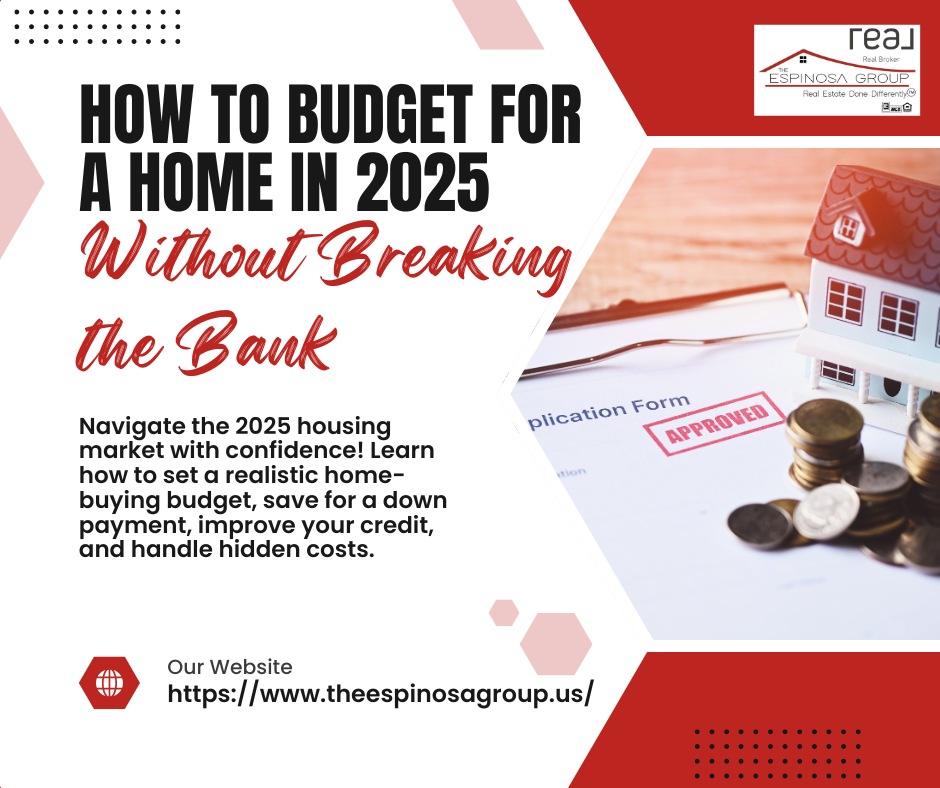How to Budget for a Home in 2025 Without Breaking the Bank
Buying a home is a significant financial milestone, but navigating the process in 2025’s economic climate requires smart planning and a clear strategy. Rising interest rates, fluctuating home prices, and inflation can make budgeting challenging, but with the right approach, you can purchase your dream home without overstretching your finances. Here’s how to create a realistic home-buying budget and stay on track.
1. Evaluate Your Financial Situation
Before you begin house hunting, take a hard look at your finances to determine what you can truly afford.
-
Calculate Your Income and Expenses:
List your monthly income and subtract essential expenses (e.g., rent, utilities, groceries, debt payments). What’s left is your discretionary income—some of which can go toward a new home. -
Assess Your Savings:
You’ll need funds for a down payment (3%-20% of the home price), closing costs (2%-5%), and additional expenses like inspections or moving costs. -
Review Your Debt-to-Income Ratio (DTI):
Lenders typically prefer a DTI below 43%. Lowering your debt can increase your borrowing power and improve your financial stability.
Pro Tip: Use a home affordability calculator to estimate a realistic budget based on your financial situation.
2. Understand 2025’s Housing Market Trends
Staying informed about the market helps you set realistic expectations for your budget.
-
Know the Median Home Price:
Research home prices in your desired area. Prices in Arizona’s market, for example, can vary widely depending on the city and neighborhood. -
Anticipate Rising Interest Rates:
Higher interest rates mean higher monthly mortgage payments. Locking in a fixed-rate mortgage early can help you avoid potential rate increases. -
Be Prepared for Competition:
In-demand areas may see bidding wars. Stick to your budget, even if you’re tempted to stretch it to win a property.
3. Build a Strong Savings Plan
Saving intentionally is key to affording a home without financial strain.
-
Automate Your Savings:
Set up a separate account for your home fund and automate deposits each month. -
Cut Back on Non-Essentials:
Reduce spending on luxuries like dining out, subscriptions, or impulse purchases. Redirect those funds into your savings. -
Take Advantage of End-of-Year Bonuses:
Many employees receive bonuses in December or January. Use this extra income to boost your home fund.
Pro Tip: Aim to save at least 20% for a down payment to avoid private mortgage insurance (PMI) and reduce your monthly payments.
4. Factor in Hidden Costs
The cost of owning a home goes beyond the purchase price. Budgeting for these expenses ensures you’re not caught off guard.
-
Ongoing Costs:
- Property taxes
- Homeowners insurance
- Maintenance and repairs
- Utility bills
-
One-Time Costs:
- Moving expenses
- Furniture and appliances
- HOA fees (if applicable)
Pro Tip: Set aside 1%-3% of your home’s value annually for maintenance and unexpected repairs.
5. Improve Your Credit Score
A higher credit score can significantly reduce your borrowing costs, saving you money in the long run.
-
Check Your Score:
Use tools like Credit Karma or AnnualCreditReport.com to review your credit and identify areas for improvement. -
Pay Down Debt:
Reducing credit card balances and paying bills on time can boost your score. -
Avoid New Credit:
Steer clear of opening new credit accounts or making large purchases on credit while planning to buy a home.
6. Get Pre-Approved for a Mortgage
Pre-approval helps you understand exactly how much you can borrow and shows sellers you’re a serious buyer.
-
Compare Lenders:
Shop around for the best interest rates and terms. Consider working with a mortgage broker to simplify the process. -
Understand Your Loan Options:
- Conventional loans: Require a higher credit score but offer flexibility.
- FHA loans: Ideal for first-time buyers with lower credit scores.
- VA loans: For eligible veterans and service members with no down payment.
Pro Tip: Avoid taking on new debt or making large financial changes during the pre-approval process to keep your application strong.
7. Stay Flexible and Patient
The right home at the right price may take time to find. Be prepared to adjust your expectations based on what’s available in your market.
-
Consider Fixer-Uppers:
Homes in need of cosmetic updates may be more affordable and allow you to build equity through renovations. -
Expand Your Search Area:
Look at homes in neighboring communities or slightly further from city centers for better value. -
Be Ready to Act:
Have your pre-approval, savings, and documentation ready so you can make an offer quickly when you find the right property.
Your Path to Homeownership in 2025
Buying a home is a journey that requires planning, patience, and discipline. By evaluating your finances, understanding market conditions, and staying focused on your goals, you can make your dream of homeownership a reality without overstretching your budget.
Need Help? The Espinosa Group is here to guide you every step of the way, from financial planning to closing on your dream home.
- Contact Us Today!
- Phone: +1(480) 584-7456
- Website: https://www.theespinosagroup.us/
Let’s make 2025 your year to buy a home without breaking the bank!
Categories
- All Blogs (225)
- Contracts, Negotiations & Process (4)
- Home Buying Process (19)
- Home Buying, Selling, and Investing Tips (65)
- how to buy a house (9)
- How to sell your house (11)
- Importance of a Real Estate Agent (1)
- real estate investment strategies (14)
- Real estate Market in Arizona (7)
- ROI tips (14)
- Selling a home (19)
- STAGING DIFFERENTLY (37)
- Staging tips for selling (23)
- THE AGENT (5)
Recent Posts













